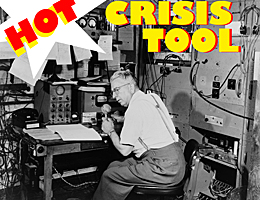


Crisis Management’s Hottest Communications Tool Today is a 19th Century Technology?
[by Howard Fencl, Hennes Communications]
A crisis boils over in your company. Your employees and critical audiences are scattered all over the globe and you need to get important information to them before rumors or misinformation are plastered across social media platforms or reported in traditional media.
What do you do? Push a message out by email? Post to your company website, mobile app and social platforms?
Yes! Yes! Do all that. But if you want to take a “belt-and-suspenders” approach, your next move is one you may be neglecting in your media outreach:
Radio.
Really. The latest Nielsen Total Audience Report offers this eye-popping stat: 92% of U.S. adults listen to radio during the average week. So don’t write off the medium as a quaint throwback – radio’s got deep audience and demographic reach. Daily listening numbers have held fairly steady – the average 18+ adult spends just under two hours daily listening to radio. That’s a lot of radio.
With those sky-high audience numbers, be sure to push your statement out to radio newsrooms along with the traditional print and TV reporters on your media list.
Shocked? I was. But radio is bit of a media zombie – it has been resurrected at least twice by new technologies.
The first is a technology we’re all familiar with – you probably drive one every day. The second wave of technologies keeping radio’s ubiquity alive are audio streaming services and smart speakers – Alexa, Amazon Echo or Google Home, for example. “Smart speakers and audio streaming services are promoting more ways for consumers to listen,” says Nielsen, and smart speakers are hands-free, so audiences don’t have to interrupt what they’re doing to tune in to radio content.
Nielsen’s report in no way diminishes the importance of TV or print reach. Eighty-eight percent of Americans tune into TV (or time-shifted TV) every week. And while the traditional print business model is shattered and print circulation continues to decline, because of the web and the reach of social media, newspapers and many magazines have more readers – and reach – than ever before.
“With each passing day, consumers are able to further customize their own media usage into an individualized experience akin to media DNA, each consumer with an ability for complete personalization,” said Peter Katsingris, Nielsen’s SVP for Audience Insights.
Radio is still an important part of your outreach arsenal in a crisis. It’s one more way to get critical messages out to the people who need it, wherever they are, whatever time of day, on whatever device they choose to use.